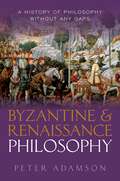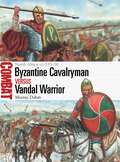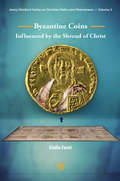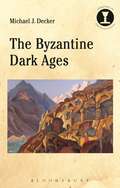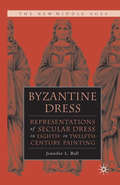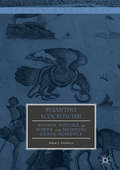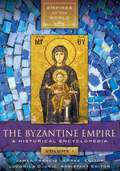- Table View
- List View
Byzantine and Renaissance Philosophy: A History of Philosophy Without Any Gaps, Volume 6 (A History of Philosophy)
by Peter AdamsonPeter Adamson explores the rich intellectual history of the Byzantine Empire and the Italian Renaissance. Peter Adamson presents an engaging and wide-ranging introduction to the thinkers and movements of two great intellectual cultures: Byzantium and the Italian Renaissance. First he traces the development of philosophy in the Eastern Christian world, from such early figures as John of Damascus in the eighth century to the late Byzantine scholars of the fifteenth century. He introduces major figures like Michael Psellos, Anna Komnene, and Gregory Palamas, and examines the philosophical significance of such cultural phenomena as iconoclasm and conceptions of gender. We discover the little-known traditions of philosophy in Syriac, Armenian, and Georgian. These chapters also explore the scientific, political, and historical literature of Byzantium. There is a close connection to the second half of the book, since thinkers of the Greek East helped to spark the humanist movement in Italy. Adamson tells the story of the rebirth of philosophy in Italy in the fifteenth and sixteenth centuries. We encounter such famous names as Christine de Pizan, Niccolò Machiavelli, Giordano Bruno, and Galileo, but as always in this book series such major figures are read alongside contemporaries who are not so well known, including such fascinating figures as Lorenzo Valla, Girolamo Savonarola, and Bernardino Telesio. Major historical themes include the humanist engagement with ancient literature, the emergence of women humanists, the flowering of Republican government in Renaissance Italy, the continuation of Aristotelian and scholastic philosophy alongside humanism, and breakthroughs in science. All areas of philosophy, from theories of economics and aesthetics to accounts of the human mind, are featured. This is the sixth volume of Adamson's History of Philosophy Without Any Gaps, taking us to the threshold of the early modern era.
The Byzantine Aristocracy and its Military Function (Variorum Collected Studies)
by Jean-Claude CheynetThe first four studies in this volume by Jean-Claude Cheynet, specially translated from French for publication here, present a broad-ranging analysis of the Byzantine aristocracy of the 8th-12th centuries. Along with the other articles in the first part, they examine the evolution of aristocratic families and the composition of this group, the relative importance of landholding and public office, the notion of 'civilian' and 'military' families, and patterns of inheritance. In the second part, the focus is on the Byzantine army, with studies looking both at the position of aristocrats within it, and more generally at the effectiveness of the army itself, notably in the campaigns in Asia Minor against the Arabs and the Turks.
The Byzantine Aristocracy and its Military Function (Variorum Collected Studies)
by Jean-Claude CheynetThe first four studies in this volume by Jean-Claude Cheynet, specially translated from French for publication here, present a broad-ranging analysis of the Byzantine aristocracy of the 8th-12th centuries. Along with the other articles in the first part, they examine the evolution of aristocratic families and the composition of this group, the relative importance of landholding and public office, the notion of 'civilian' and 'military' families, and patterns of inheritance. In the second part, the focus is on the Byzantine army, with studies looking both at the position of aristocrats within it, and more generally at the effectiveness of the army itself, notably in the campaigns in Asia Minor against the Arabs and the Turks.
Byzantine Art and Renaissance Europe
by Angeliki Lymberopoulou Rembrandt DuitsByzantine Art and Renaissance Europe discusses the cultural and artistic interaction between the Byzantine east and western Europe, from the sack of Constantinople by the Fourth Crusade in 1204 to the flourishing of post-Byzantine artistic workshops on Venetian Crete during the fifteenth and sixteenth centuries and the formation of icon collections in Renaissance Italy. The contributors examine the routes by which artistic interaction may have taken place, and explore the reception of Byzantine art in western Europe, analysing why artists and patrons were interested in ideas from the other side of the cultural and religious divide. In the first chapter, Lyn Rodley outlines the development of Byzantine art in the Palaiologan era and its relations with western culture. Hans Bloemsma then re-assesses the influence of Byzantine art on early Italian painting from the point of view of changing demands regarding religious images in Italy. In the first of two chapters on Venetian Crete, Angeliki Lymberopoulou evaluates the impact of the Venetian presence on the production of fresco decorations in regional Byzantine churches on the island. The next chapter, by Diana Newall, continues the exploration of Cretan art manufactured under the Venetians, shifting the focus to the bi-cultural society of the Cretan capital Candia and the rise of the post-Byzantine icon. Kim Woods then addresses the reception of Byzantine icons in western Europe in the late Middle Ages and their role as devotional objects in the Roman Catholic Church. Finally, Rembrandt Duits examines the status of Byzantine icons as collectors’ items in early Renaissance Italy. The inventories of the Medici family and other collectors reveal an appreciation for icons among Italian patrons, which suggests that received notions of Renaissance tastes may be in need of revision. The book thus offers new perspectives and insights and re-positions late and post-Byzantine art in a broader European cultural context.
Byzantine Art and Renaissance Europe
by Angeliki Lymberopoulou Rembrandt DuitsByzantine Art and Renaissance Europe discusses the cultural and artistic interaction between the Byzantine east and western Europe, from the sack of Constantinople by the Fourth Crusade in 1204 to the flourishing of post-Byzantine artistic workshops on Venetian Crete during the fifteenth and sixteenth centuries and the formation of icon collections in Renaissance Italy. The contributors examine the routes by which artistic interaction may have taken place, and explore the reception of Byzantine art in western Europe, analysing why artists and patrons were interested in ideas from the other side of the cultural and religious divide. In the first chapter, Lyn Rodley outlines the development of Byzantine art in the Palaiologan era and its relations with western culture. Hans Bloemsma then re-assesses the influence of Byzantine art on early Italian painting from the point of view of changing demands regarding religious images in Italy. In the first of two chapters on Venetian Crete, Angeliki Lymberopoulou evaluates the impact of the Venetian presence on the production of fresco decorations in regional Byzantine churches on the island. The next chapter, by Diana Newall, continues the exploration of Cretan art manufactured under the Venetians, shifting the focus to the bi-cultural society of the Cretan capital Candia and the rise of the post-Byzantine icon. Kim Woods then addresses the reception of Byzantine icons in western Europe in the late Middle Ages and their role as devotional objects in the Roman Catholic Church. Finally, Rembrandt Duits examines the status of Byzantine icons as collectors’ items in early Renaissance Italy. The inventories of the Medici family and other collectors reveal an appreciation for icons among Italian patrons, which suggests that received notions of Renaissance tastes may be in need of revision. The book thus offers new perspectives and insights and re-positions late and post-Byzantine art in a broader European cultural context.
Byzantine Athens, 10th - 12th Centuries
by Charalambos BourasIn this masterful synthesis, Charalambos Bouras draws together material and textual evidence for Athens in the Middle Byzantine period, from the mid-tenth century to 1204, when it was conquered by Crusaders. What emerges from his meticulous investigation is an urban fabric surprisingly makeshift in its domestic sector yet exuberantly creative in its ecclesiastical architecture. Rather than viewing the city as a mere shadow of its ancient past, Bouras demonstrates how Athens remained an important city of the Byzantine Empire as the seat of a metropolitan, home to local aristocracy, and pilgrimage destination for those who came to worship at the Christian Parthenon. Byzantine Athens explores the relationship of the Byzantine infrastructure to earlier configurations, shedding light on the water supply, industrial facilities, streets and fortifications of medieval Athens, and exploring the evidence for the form and typology of Byzantine houses. Thanks to Bouras’s indefatigable study of all available archaeological reports the first part of the book offers an overall picture of the Middle Byzantine city. The second part presents a fully documented and illustrated catalogue of nearly 40 churches, including synthetic treatments of their typology and morphology set in the wider Byzantine architectural context. Finally, Bouras joins his unrivalled knowledge of the surviving remains and exhaustive scrutiny of the relevant scholarship to offer a historical interpretation of the Athenian monuments. Byzantine Athens is a unique achievement that will remain an invaluable compendium of our knowledge of one of the most complex, yet relatively unknown, Byzantine cities.
Byzantine Athens, 10th - 12th Centuries
by Charalambos BourasIn this masterful synthesis, Charalambos Bouras draws together material and textual evidence for Athens in the Middle Byzantine period, from the mid-tenth century to 1204, when it was conquered by Crusaders. What emerges from his meticulous investigation is an urban fabric surprisingly makeshift in its domestic sector yet exuberantly creative in its ecclesiastical architecture. Rather than viewing the city as a mere shadow of its ancient past, Bouras demonstrates how Athens remained an important city of the Byzantine Empire as the seat of a metropolitan, home to local aristocracy, and pilgrimage destination for those who came to worship at the Christian Parthenon. Byzantine Athens explores the relationship of the Byzantine infrastructure to earlier configurations, shedding light on the water supply, industrial facilities, streets and fortifications of medieval Athens, and exploring the evidence for the form and typology of Byzantine houses. Thanks to Bouras’s indefatigable study of all available archaeological reports the first part of the book offers an overall picture of the Middle Byzantine city. The second part presents a fully documented and illustrated catalogue of nearly 40 churches, including synthetic treatments of their typology and morphology set in the wider Byzantine architectural context. Finally, Bouras joins his unrivalled knowledge of the surviving remains and exhaustive scrutiny of the relevant scholarship to offer a historical interpretation of the Athenian monuments. Byzantine Athens is a unique achievement that will remain an invaluable compendium of our knowledge of one of the most complex, yet relatively unknown, Byzantine cities.
Byzantine Cavalryman vs Vandal Warrior: North Africa AD 533–36 (Combat)
by Murray DahmFully illustrated, this enthralling study explores how the Vandals in North Africa attempted to defend their kingdom against the resurgent Byzantine Empire during 533–36.In AD 533, the Byzantine Emperor Justinian I launched the first of his campaigns to reconquer the Western Roman Empire. This effort began in North Africa (modern Algeria and Tunisia), targeting the Vandal kingdom established there a century earlier, which also included Sardinia, Corsica and the Balearic Islands. Featuring full-colour artwork and mapping alongside carefully chosen archive illustrations, this book shows how the Byzantine general Belisarius established his formidable reputation in the lightning-fast campaign that ensued, exploring the origins, tactics and reputation of the two sides' forces as they fought for control of North Africa.The landing of Belisarius' forces took the Vandal king, Gelimer, completely by surprise; in September 533 the two sides met in battle near Carthage in an encounter known to posterity as Ad Decimum, with Gelimer ambitiously attempting to trap Belisarius' forces as they advanced. In December, the two sides fought again in a momentous clash at Tricamarum, where the fate of Gelimer's regime would be determined. A third battle ensued in 536, when the rebel Stotzas' Byzantine and Vandal troops confronted Belisarius' forces, the outcome sealing the Byzantine general's standing as the foremost soldier of his age.Featuring specially commissioned artwork and mapping alongside archive illustrations and photographs, this vivid account compares and assesses the two sides' fighting men as they vied for supremacy in North Africa.
Byzantine Cavalryman vs Vandal Warrior: North Africa AD 533–36 (Combat)
by Murray DahmFully illustrated, this enthralling study explores how the Vandals in North Africa attempted to defend their kingdom against the resurgent Byzantine Empire during 533–36.In AD 533, the Byzantine Emperor Justinian I launched the first of his campaigns to reconquer the Western Roman Empire. This effort began in North Africa (modern Algeria and Tunisia), targeting the Vandal kingdom established there a century earlier, which also included Sardinia, Corsica and the Balearic Islands. Featuring full-colour artwork and mapping alongside carefully chosen archive illustrations, this book shows how the Byzantine general Belisarius established his formidable reputation in the lightning-fast campaign that ensued, exploring the origins, tactics and reputation of the two sides' forces as they fought for control of North Africa.The landing of Belisarius' forces took the Vandal king, Gelimer, completely by surprise; in September 533 the two sides met in battle near Carthage in an encounter known to posterity as Ad Decimum, with Gelimer ambitiously attempting to trap Belisarius' forces as they advanced. In December, the two sides fought again in a momentous clash at Tricamarum, where the fate of Gelimer's regime would be determined. A third battle ensued in 536, when the rebel Stotzas' Byzantine and Vandal troops confronted Belisarius' forces, the outcome sealing the Byzantine general's standing as the foremost soldier of his age.Featuring specially commissioned artwork and mapping alongside archive illustrations and photographs, this vivid account compares and assesses the two sides' fighting men as they vied for supremacy in North Africa.
Byzantine Childhood: Representations and Experiences of Children in Middle Byzantine Society (Routledge Research in Byzantine Studies)
by Oana-Maria CojocaruByzantine Childhood examines the intricacies of growing up in medieval Byzantium, children’s everyday experiences, and their agency. By piecing together a wide range of sources and utilising several methodological approaches inspired by intersectionality, history from below and microhistory, it analyses the life course of Byzantine boys and girls and how medieval Byzantine society perceived and treated them according to societal and cultural expectations surrounding age, gender, and status. Ultimately, it seeks to reconstruct a more plausible picture of the everyday life of children, one of the most vulnerable social groups throughout history and often a neglected subject in scholarship. Written in a lively and engaging manner, this book is necessary reading for scholars and students of Byzantine history, as well as those interested in the history of childhood and the family.
Byzantine Childhood: Representations and Experiences of Children in Middle Byzantine Society (Routledge Research in Byzantine Studies)
by Oana-Maria CojocaruByzantine Childhood examines the intricacies of growing up in medieval Byzantium, children’s everyday experiences, and their agency. By piecing together a wide range of sources and utilising several methodological approaches inspired by intersectionality, history from below and microhistory, it analyses the life course of Byzantine boys and girls and how medieval Byzantine society perceived and treated them according to societal and cultural expectations surrounding age, gender, and status. Ultimately, it seeks to reconstruct a more plausible picture of the everyday life of children, one of the most vulnerable social groups throughout history and often a neglected subject in scholarship. Written in a lively and engaging manner, this book is necessary reading for scholars and students of Byzantine history, as well as those interested in the history of childhood and the family.
Byzantine Chronicles and the Sixth Century (Variorum Collected Studies)
by Roger ScottByzantine chronicles have traditionally been regarded as a somewhat inferior form of Byzantine history writing, especially in comparison with 'classicizing' historians. The aim of many of these papers is both to rescue the reputation of the Byzantine chroniclers, especially Malalas and Theophanes, and also to provide some examples of how these two chroniclers in particular can be exploited usefully both to reveal aspects of the past itself, notably of the period of Justinian, and also of how the Byzantines interpreted their own past, which included on occasions rewriting that past to suit altered contemporary needs. For the period of Justinian in particular, proper attention to aspects of the humble Byzantine chronicle can also help achieve a better understanding of the period than that provided by the classicizing Procopius with his emphasis on war and conquest. By considering more general aspects of the place of history-writing in Byzantine culture, the papers also help explain why history remained such an important aspect of Byzantine culture.
Byzantine Chronicles and the Sixth Century (Variorum Collected Studies)
by Roger ScottByzantine chronicles have traditionally been regarded as a somewhat inferior form of Byzantine history writing, especially in comparison with 'classicizing' historians. The aim of many of these papers is both to rescue the reputation of the Byzantine chroniclers, especially Malalas and Theophanes, and also to provide some examples of how these two chroniclers in particular can be exploited usefully both to reveal aspects of the past itself, notably of the period of Justinian, and also of how the Byzantines interpreted their own past, which included on occasions rewriting that past to suit altered contemporary needs. For the period of Justinian in particular, proper attention to aspects of the humble Byzantine chronicle can also help achieve a better understanding of the period than that provided by the classicizing Procopius with his emphasis on war and conquest. By considering more general aspects of the place of history-writing in Byzantine culture, the papers also help explain why history remained such an important aspect of Byzantine culture.
The Byzantine City from Heraclius to the Fourth Crusade, 610–1204: Urban Life after Antiquity (New Approaches to Byzantine History and Culture)
by Luca ZavagnoThis book explores the Byzantine city and the changes it went through from 610 to 1204. Throughout this period, cities were always the centers of political and social life for both secular and religious authorities, and, furthermore, the focus of the economic interests of local landowning elites. This book therefore examines the regional and subregional trajectories in the urban function, landscape, structure and fabric of Byzantium’s cities, synthesizing the most cutting-edge archaeological excavations, the results of analyses of material culture (including ceramics, coins, and seals) and a reassessment of the documentary and hagiographical sources. The transformation the Byzantine urban landscape underwent from the seventh to thirteenth centuries can afford us a better grasp of changes to the Byzantine central and provincial administrative apparatus; their fiscal machinery, military institutions, socio-economic structures and religious organization. This book will be of interest to students and researchers of the history, archaeology and architecture of Byzantium.
Byzantine Coins Influenced by the Shroud of Christ
by Giulio FantiNumerous studies have been carried out on Byzantine coins, but there are still no univocal interpretations on the details of the figures represented there and in particular on those relating to Jesus Christ. The information derived from the studies on the Holy Shroud, the most important Relic of Christ in Christianity, has clearly resulted in some new interpretations. This is the first book in the world that deals extensively with the effigy of Christ, despite being the most sought after and collected by numismatists. Furthermore, the book relates the different images of the Redeemer on Byzantine coins with the image of Jesus Christ on the Shroud, the most important Relic of Christianity. The numerous collectors will therefore be interested in having not only a numismatic analysis of these coins but also a historical-religious study. This book, which should be understandable to everyone, demonstrates the strong influence that the Shroud had in the Byzantine era.
Byzantine Coins Influenced by the Shroud of Christ
by Giulio FantiNumerous studies have been carried out on Byzantine coins, but there are still no univocal interpretations on the details of the figures represented there and in particular on those relating to Jesus Christ. The information derived from the studies on the Holy Shroud, the most important Relic of Christ in Christianity, has clearly resulted in some new interpretations. This is the first book in the world that deals extensively with the effigy of Christ, despite being the most sought after and collected by numismatists. Furthermore, the book relates the different images of the Redeemer on Byzantine coins with the image of Jesus Christ on the Shroud, the most important Relic of Christianity. The numerous collectors will therefore be interested in having not only a numismatic analysis of these coins but also a historical-religious study. This book, which should be understandable to everyone, demonstrates the strong influence that the Shroud had in the Byzantine era.
Byzantine Constantinople: Monuments, Topography and Everyday Life (PDF) (The Medieval Mediterranean #33)
by Nevra NecipogluThis collection of papers on the city of Constantinople by a distinguished group of Byzantine historians, art historians, and archaeologists provides new perspectives as well as new evidence on the monuments, topography, social and economic life of the Byzantine imperial capital.
The Byzantine Dark Ages (Debates in Archaeology)
by Michael J. DeckerThe Byzantine Dark Ages explores current debates about the sudden transformation of the Byzantine Empire in the wake of environmental, social and political changes. Those studying the Byzantine Empire, the successor to the Roman Empire in the eastern Mediterranean, have long recognized that the mid-7th century CE ushered in sweeping variations in the way of life of many inhabitants of the Mediterranean world, with evidence of the decline of the size and economic prosperity of cities, a sharp fall in expressions of literary culture, the collapse in trade networks, and economic and political instability.Michael J. Decker looks at the material evidence for the 7th to 9th centuries, lays out the current academic discourse about its interpretation, and suggests new ways of thinking about this crucial era. Important to readers interested in understanding how and why complex societies and imperial systems undergo and adapt to stresses, this clearly written, accessible work will also challenge students of archaeology and history to think in new ways when comprehending the construction of the past.
The Byzantine Dark Ages (Debates in Archaeology)
by Michael J. DeckerThe Byzantine Dark Ages explores current debates about the sudden transformation of the Byzantine Empire in the wake of environmental, social and political changes. Those studying the Byzantine Empire, the successor to the Roman Empire in the eastern Mediterranean, have long recognized that the mid-7th century CE ushered in sweeping variations in the way of life of many inhabitants of the Mediterranean world, with evidence of the decline of the size and economic prosperity of cities, a sharp fall in expressions of literary culture, the collapse in trade networks, and economic and political instability.Michael J. Decker looks at the material evidence for the 7th to 9th centuries, lays out the current academic discourse about its interpretation, and suggests new ways of thinking about this crucial era. Important to readers interested in understanding how and why complex societies and imperial systems undergo and adapt to stresses, this clearly written, accessible work will also challenge students of archaeology and history to think in new ways when comprehending the construction of the past.
Byzantine Dress: Representations of Secular Dress (The New Middle Ages)
by J. BallIn Byzantium there were two overlapping systems of dress: a semiotic one whereby dress was a code for rank and wealth, and a fashion system where dress was based on the desire to look a certain way. This book explains secular dress from the eighth to the twelfth centuries through an examination of painted representations.
Byzantine Ecocriticism: Women, Nature, and Power in the Medieval Greek Romance
by Adam J. GoldwynByzantine Ecocriticism: Women, Nature, and Power in the Medieval Greek Romance applies literary ecocriticism to the imaginative fiction of the Greek world from the twelfth to fifteenth centuries. Through analyses of hunting, gardening, bride-stealing, and warfare, Byzantine Ecocriticism exposes the attitudes and behaviors that justified human control over women, nature, and animals; the means by which such control was exerted; and the anxieties surrounding its limits. Adam Goldwyn thus demonstrates the ways in which intersectional ecocriticism, feminism, and posthumanism can be applied to medieval texts, and illustrates how the legacies of medieval and Byzantine environmental practice and ideology continue to be relevant to contemporary ecological and environmental concerns.
Byzantine Ecocriticism: Women, Nature, and Power in the Medieval Greek Romance
by Adam J. GoldwynByzantine Ecocriticism: Women, Nature, and Power in the Medieval Greek Romance applies literary ecocriticism to the imaginative fiction of the Greek world from the twelfth to fifteenth centuries. Through analyses of hunting, gardening, bride-stealing, and warfare, Byzantine Ecocriticism exposes the attitudes and behaviors that justified human control over women, nature, and animals; the means by which such control was exerted; and the anxieties surrounding its limits. Adam Goldwyn thus demonstrates the ways in which intersectional ecocriticism, feminism, and posthumanism can be applied to medieval texts, and illustrates how the legacies of medieval and Byzantine environmental practice and ideology continue to be relevant to contemporary ecological and environmental concerns.
The Byzantine Empire [2 volumes]: A Historical Encyclopedia [2 volumes] (Empires of the World)
by James Francis LePreeAn indispensable resource for investigating the history of the Byzantine Empire, this book provides a comprehensive summary of its overall development as well as its legacy in the modern world.The existence and development of Byzantium covers more than a millennium and coincides with one of the darkest periods of European history. Unfortunately, the Empire's achievements and brightest moments remain largely unknown except to Byzantine scholars. Through reference entries and primary source documents, this encyclopedia provides essential information about the Byzantine Empire from the reign of Diocletian to the Fall of Constantinople.The reference entries are grouped in eight topical sections on the most significant aspects of the history of the Byzantine Empire. These sections include individuals, key events, key places, the military, objects and artifacts, administration and organization, government and politics, and groups and organizations. Each section begins with an overview essay and contains approximately thirty entries on carefully selected topics. The entries conclude with suggestions for further reading along with cross-references., A selection of primary source documents gives readers first-hand accounts of the Byzantine world.
The Byzantine Empire [2 volumes]: A Historical Encyclopedia [2 volumes] (Empires of the World)
by James Francis LePree Ljudmila DjukicAn indispensable resource for investigating the history of the Byzantine Empire, this book provides a comprehensive summary of its overall development as well as its legacy in the modern world.The existence and development of Byzantium covers more than a millennium and coincides with one of the darkest periods of European history. Unfortunately, the Empire's achievements and brightest moments remain largely unknown except to Byzantine scholars. Through reference entries and primary source documents, this encyclopedia provides essential information about the Byzantine Empire from the reign of Diocletian to the Fall of Constantinople.The reference entries are grouped in eight topical sections on the most significant aspects of the history of the Byzantine Empire. These sections include individuals, key events, key places, the military, objects and artifacts, administration and organization, government and politics, and groups and organizations. Each section begins with an overview essay and contains approximately thirty entries on carefully selected topics. The entries conclude with suggestions for further reading along with cross-references., A selection of primary source documents gives readers first-hand accounts of the Byzantine world.
Byzantine Greece: Papers from the Forty-sixth Spring Symposium of Byzantine Studies (Publications of the Society for the Promotion of Byzantine Studies #20)
by Archibald DunnThis volume offers a structured presentation of the progress of research into the internal history of a part of the Byzantine world – Greece – in the centuries before the multiple changes induced or accelerated by the Fourth Crusade. Greece is a large area (several Early andMiddle Byzantine provinces), with records, archival, literary, archaeological, architectural, and art-historical, most of which are unequalled in terms of their density and range. This creates opportunities for useful synthesis, and for dialogue with those now engaged in the rewriting, or writing, of the inner history of Byzantium, from Italy to the Caucasus, who have been stimulated by, or involved in, the editing of archives and inscriptions (including sigillographic), and in the publication of monuments, excavations, and surveys (for all of which the ‘Greek space’, the elladikê khôra, is a particular, and fertile, focus of activity, as the conference showed). Much of the material presented here can usually only be found in specialised publication, and indeed much in Greek alone. But, properly contextualised, this material about the ‘Greek space’ deserves to be brought into the dialogues or debates at the heart of Byzantine Studies, for instance about the Late Antique ‘boom’, urban life, the ‘Dark Age’, economic change, the nature of the ‘Byzantine revival’, and of social, socio-economic, and ethnic groups. The studies here synthesise such research, enabling the ‘Greek space’ as a case study in the evolution of a significant region to the west of Constantinople, to take its place more fully as a point of reference in such dialogues or debates. Equally, it provides frameworks for archaeologists dealing with Greece from Late Antiquity onwards – and there are now many – with which to engage, and it makes available a rich source of comparative material for those studying the other regions of the Byzantine world, whether historically or archaeologically, in Southeastern Europe, Italy, or Turkey.
